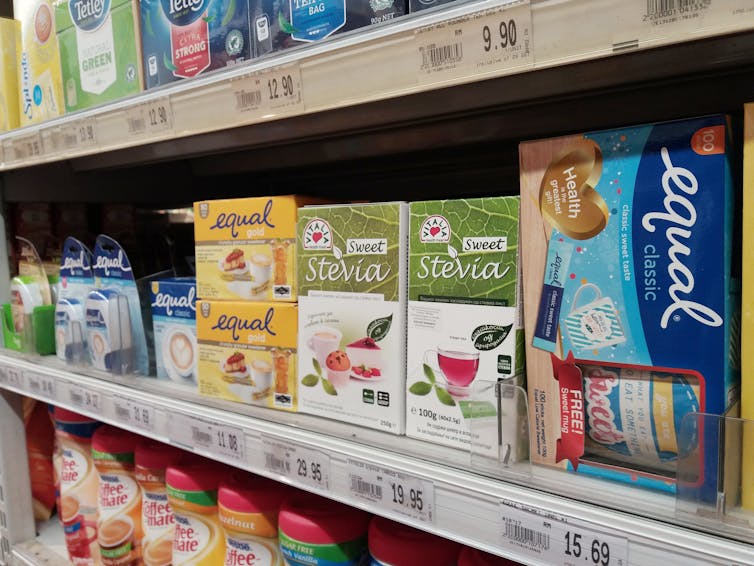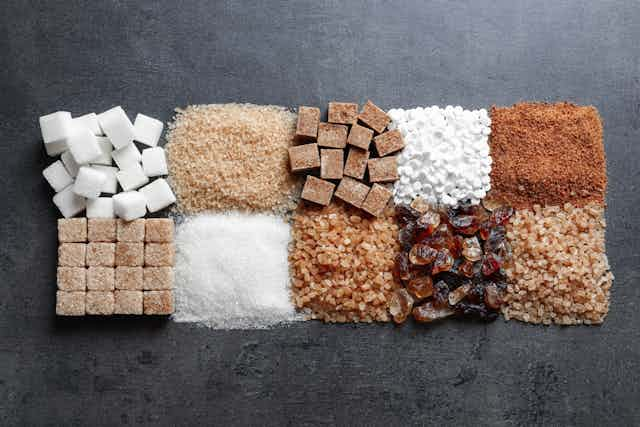Wandering through the grocery store, it is easy to be overwhelmed by the numerous brands and health claims on the dozens of sugar substitutes. It can be particularly confusing for those with diabetes or pre-diabetes who must keep their blood sugar in check and control their weight.
With the growing diabetes and obesity epidemic, there has been increasing awareness around the use of added sugars in foods. The most recent edition of the U.S. Dietary Guidelines for Americans recommends that added sugars should be kept to less than 10% of the calories consumed, which turns out to be roughly 270 calories per day.
This is because “added sugars” add sweetness or flavor but add very little nutritional value. Because of this trend, the food industry has embarked on a quest to find or develop the perfect substitute to replace sugar – with the same taste and none of the calories that lead to weight gain.
As a pharmacist who is also board certified in advanced diabetes management, I talk to patients every day about blood sugars and ways to help them take control of their diabetes. They often ask me whether the perfect substitute to sugar has been found. The short answer is no. Here is the long answer.

Sugar alcohols
Sugar substitutes can be categorized into two main groups: sugar alcohols and high intensity sweeteners. The sugar alcohols include sorbitol, xylitol, lactitol, mannitol, erythritol and maltitol. High-intensity sweeteners include saccharin, aspartame, acesulfame potassium (Ace-K), sucralose, neotame, advantame, stevia, and Siraitia grosvenorii Swingle fruit extract (SGFE).
Sugar alcohols are often found in toothpaste, chewing gum, and some “sugar-free” foods. They are carbohydrates with a chemical structure that resembles sugar, but also the components that make them an alcohol. They are about 25-100% sweeter than sugar and have a similar taste. But here is the catch: They are not calorie free. Most have between 1.5 and two calories per gram. Now compare the calorie count to sugar, also known as sucrose, which has four calories per gram – twice as much.

Although sugar alcohols contain fewer calories, they will still increase a patient’s blood sugar, especially when eaten in excess. When compared to sugar, the effect is less dramatic though. This is because of how these molecules are processed in the body. We measure this using the glycemic index.
The glycemic index is a reference to how quickly a food is broken down and absorbed. The higher the number, the more quickly the food breaks down and the faster the sugar goes into the blood. Sucrose has a glycemic index of 65; whereas sugar alcohols, like xylitol, have a glycemic index of around seven. This means that sugar alcohols are harder to digest, and cause a slower and lower increase in post-meal blood sugars – which is typically better for people with diabetes. Because sugar alcohols are harder for the body to break down though, some of them remain in the gut, and if a person consumes too much they may experience digestive complaints like gas, cramping and diarrhea.
Here is the other downside to foods containing sugar alcohols: They often have higher quantities of fat or salt to make up for the lower sugar content.
Artificial sweeteners
High-intensity sweeteners, are zero- or low-calorie alternatives to sugar. They are made from a variety of sources, and are 100 to 20,000 times as sweet as sugar. Some leave a bitter or metallic taste behind. Two newer substitutes – stevia and SGFE – come from plants and are at times referred to as “natural” substitutes.
According to the American Diabetes Association 2019 guidelines, the use of high-intensity sweeteners may decrease calorie and carbohydrate intake. However, you cannot replace these “free” calories with calories from other food sources, you will lose or the benefits on blood sugar control and weight loss.
Researchers have seen this in some of the studies on high-intensity sweeteners. Some of the trials show no difference or even a possible increase in weight. But in other studies where intake of food is better regulated and patients don’t replace these free calories with other high-caloric foods, the weight loss is maintained.
The takeaway
All sugar substitutes are labeled as food additives and are under the regulation of the U.S. Food and Drug Administration. The latest trend has been labeling some of the sugar substitutes as “derived from plants” or “natural.” That does not necessarily mean that these are safer or more effective in blood sugar control or weight loss. If it is used in excess, side effects such as bloating or diarrhea may still result.
Several concerns by researchers have been raised about high-intensity sweeteners – saccharin and aspartame – and cancer. To date, the National Cancer Institute has concluded that there is no clear evidence that any of the high-intensity sweeteners is associated with an increased risk of cancer.
As a pharmacist specializing in advanced diabetes, I talk to patients every day about how to control their blood sugar level and their diabetes. There are three main ways to do that: medication, increased activity and diet. The last two are probably more important in the long run.
If diet and activity level never change, it is really hard to help patients bring their blood sugars down. Medication after medication will likely have to be added. With this comes the potential for side effects. So if I can persuade patients to make changes to their diet, like switching to a beverage with a sugar substitute, it makes a huge difference in helping to control blood sugars and the dose of medications.
The overall focus for diabetes management should be on reducing the consumption of sugar-sweetened beverages and foods. If you can switch one of these sugar-sweetened products to a food that has a high-intensity sugar substitute, that is better. But best of all is consuming food and drinks that are not highly processed and do not have added sugars.

